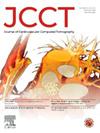基于冠状动脉 CT 血管造影的全自动定量血流比率的诊断性能。
IF 5.5
2区 医学
Q1 CARDIAC & CARDIOVASCULAR SYSTEMS
引用次数: 0
摘要
背景:基于墨累律的定量血流比值(即μFR)最近得到了验证,可在阴道实验室从冠状动脉造影图像中计算分数血流储备(FFR)。最近,μFR 算法被应用于冠状动脉计算机断层扫描(CCTA),半自动计算的μFR(CT-μFR)在将患者转诊至阴道实验室之前识别血流受限的冠状动脉病变方面显示出良好的准确性。我们的目的是评估一种人工智能驱动的全自动 CCTA 重建和 CT-μFR 计算方法的诊断准确性,并以阴道实验室生理学作为参考标准:这是对前瞻性 CAREER 试验(NCT04665817)的事后盲法分析。纳入了 30 天内接受 CCTA、冠状动脉造影术(包括 FFR)的患者。确定血流动力学显著性冠状动脉狭窄的心电图生理学标准是FFR≤0.80,如果没有FFR,则μFR≤0.80:242名患者的657条血管成功实现了CCTA自动重建和CT-μFR计算。CT-μFR显示出良好的相关性(r = 0.62,p全自动 CT-μFR 在将患者转诊至阴道实验室之前识别血流动力学显著狭窄的患者方面具有很高的可行性和良好的诊断性能。本文章由计算机程序翻译,如有差异,请以英文原文为准。
Diagnostic performance of fully automatic coronary CT angiography-based quantitative flow ratio
Background
Murray-law based quantitative flow ratio, namely μFR, was recently validated to compute fractional flow reserve (FFR) from coronary angiographic images in the cath lab. Recently, the μFR algorithm was applied to coronary computed tomography angiography (CCTA) and a semi-automated computed μFR (CT-μFR) showed good accuracy in identifying flow-limiting coronary lesions prior to referral of patients to the cath lab. We aimed to evaluate the diagnostic accuracy of an artificial intelligence-powered method for fully automatic CCTA reconstruction and CT-μFR computation, using cath lab physiology as reference standard.
Methods
This was a post-hoc blinded analysis of the prospective CAREER trial (NCT04665817). Patients who underwent CCTA, coronary angiography including FFR within 30 days were included. Cath lab physiology standard for determining hemodynamically significant coronary stenosis was defined as FFR≤0.80, or μFR≤0.80 when FFR was not available.
Results
Automatic CCTA reconstruction and CT-μFR computation was successfully achieved in 657 vessels from 242 patients. CT-μFR showed good correlation (r = 0.62, p < 0.001) and agreement (mean difference = −0.01 ± 0.10, p < 0.001) with cath lab physiology standard. Patient-level diagnostic accuracy for CT-μFR to identify patients with hemodynamically significant stenosis was 83.0 % (95%CI: 78.3%–87.8 %), with sensitivity, specificity, positive and negative predictive value, positive and negative likelihood ratio of 84.2 %, 81.9 %, 82.1 %, 84.0 %, 4.7 and 0.2, respectively. Average analysis time for CT-μFR was 1.60 ± 0.34 min per patient.
Conclusion
The fully automatic CT-μFR yielded high feasibility and good diagnostic performance in identifying patients with hemodynamically significant stenosis prior to referral of patients to the cath lab.
求助全文
通过发布文献求助,成功后即可免费获取论文全文。
去求助
来源期刊

Journal of Cardiovascular Computed Tomography
CARDIAC & CARDIOVASCULAR SYSTEMS-RADIOLOGY, NUCLEAR MEDICINE & MEDICAL IMAGING
CiteScore
7.50
自引率
14.80%
发文量
212
审稿时长
40 days
期刊介绍:
The Journal of Cardiovascular Computed Tomography is a unique peer-review journal that integrates the entire international cardiovascular CT community including cardiologist and radiologists, from basic to clinical academic researchers, to private practitioners, engineers, allied professionals, industry, and trainees, all of whom are vital and interdependent members of our cardiovascular imaging community across the world. The goal of the journal is to advance the field of cardiovascular CT as the leading cardiovascular CT journal, attracting seminal work in the field with rapid and timely dissemination in electronic and print media.
 求助内容:
求助内容: 应助结果提醒方式:
应助结果提醒方式:


